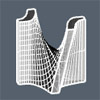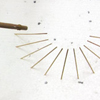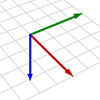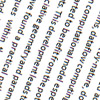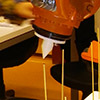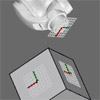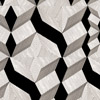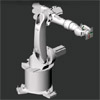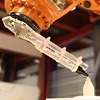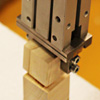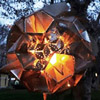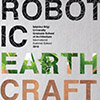This project is developed in the summer workshop titled Robotic Earthcrafts conducted at İstanbul Bilgi University Architectural Design graduate program. Students call this project “ZOM”. Students are Murat Sökün, Zeynep Çakmak, and Özlem Güven. We organized the workshop together with Fulya Akipek and Hülya Oral. You can find more details about the workshop here. In this project, a simple robot code created the EPS molds of the rammed-earth module. Below […]
Today, we tried to understand one of the ways of generating multiple planes in Grasshopper. This is an important step in utilizing the robot program efficiently. Instead of manually jogging the robot, we designed the path that the robot will dig lots of chopsticks. In the “Robotic Chopstick Digger Exercise”, every student designed their own paths and decided the height, orientation, and number of sticks to be dug on an […]
In the Digital Fabrication course, I needed to explain the plane orientation and rotation angles. This is why I prepared this Spatial Recognition Test. This is an important topic regarding the matching of the TCP (tool center point) plane of the robot and the plane(s) designers generate. In Rhino, we define a construction plane by red (X), green (Y), and blue (Z) colors. The relative positions among those axes are […]
This paper covers ongoing research titled “Growing an Architectural System”. It is an interdisciplinary work relating permaculture studies with computational design and production technologies. It includes testing some issues of performance via full-scale prototypes. Growing Pots is the first study we will mention in the paper. It is about the design of a micro-permaculture system and 3d printed products realized by students of an elective course. On the other hand, […]
Today in the Digital Fabrication course, we examined digital-physical translations utilizing the robots add-on for Grasshopper. Students learn how to get coordinate data from a physical environment, use it in the digital model and apply it to a robot motion. We aimed to dig chopsticks into an EPS block by using a special wooden tool called “Chopstick Digger”. In the first hour of the class, we attached the “pointer” tool, […]
In the Digital Fabrication course, we are in the middle of a sea, full of technical details, and students need motivation. This is why I felt I should do something simple and educational but funny at the same time; a “kissing the cube” exercise. The planned exercise was about programming the robot to touch every facet of a cube without colliding with it. Of course, we couldn’t manage to kiss […]
One of the new assignments of our Computation-based Basic Design studio is called “Self-Organizing Patterns”. Although I’m not very sure about their self-organization potential, there are several good examples of systematic pattern-making. In the third week of their design education, some of the students proved themselves very well in analyzing and re-configuring natural structures in 2D abstract compositions. Selina Şişik Kardelen Kurt Sude Aydın
Today, we started learning Robots add-on for Grasshopper. The first two codes we experimented with were similar to the first week’s jogging exercises. In the first one called “axial jogging”, we had 6 number sliders to control the angles of the axes. Every number slider generates values between -Pi and +Pi. These numbers are joined into a text by adding a comma in between. Then, Create program and Simulate Program […]
On the second day of the Digital Fabrication course, we tried to understand what is a “tool” and how to draw/ produce/ attach/calibrate a simple penholder tool for our robot. This study will hopefully make students aware of the effects of these procedures in robotic design and fabrication. The tool we used here is based on this Rhino drawing laser-cut from a waste plexiglass sheet. The flange of our robot has a diameter […]
This is a competition entry on the innovative uses of natural stone. Urban Polyhedra aims to organize the natural stone usage, especially on the shores. In the current implementation of this system, random blocks are placed to prevent landslides on the urban coastal areas, but restrict the interaction of the citizens with the shore, and destroy the spaces for sea creatures, and vegetation. Thus, this random placement makes it difficult […]
In this semester, I started a new elective course at İstanbul Bilgi University Faculty of Architecture. Second, third and fourth-year architecture, interior design, and industrial design students attend the course titled “Digital Fabrication”. I am very excited to study the basics of robotic fabrication together with the students. I’ll try to report the content of the lectures and the robot exercises on designcoding.net. Below is the general brief of the […]
This is the first assignment named Design in the Forest of the new “Computation-based Basic Design” curriculum at İstanbul Bilgi University Faculty of Architecture. We are excited to see the students merging their conceptions of natural structures with the skills they start gaining in geometry classes. In the next assignments, we expect to generate patterns and structures by the abstraction of these initial sketches. Humay Aliyeva Sude Akay Here is an […]
In the first-year Computation Based Basic Design studio at İstanbul Bilgi University, the aim is to help students understand that design, due to its prevalent relational nature incorporates different forms of reasoning as indispensable constituents within the creative process (Yalınay Çinici, 2013). The studio integrates the 1:1 scale construction via computational thinking which consists of geometric relations, material computation/performance, and CAD/CAM technologies. The aim of the studio is to develop an awareness of immediate or far surroundings […]
Can digital design and robot technology be integrated with an ecological design approach? The robotic earthcrafts workshop at Istanbul Bilgi University attempts to relate to biological parameters and digital design and fabrication processes. Thus, the summer school will include seminars and practices on computational design, robotic fabrication, rammed-earth construction techniques, and permaculture design principles to discuss and experience the relationships between technology and ecology. So, the results will be the […]
This is the basketball cup that won the design contest organized in 2018 by the Turkish Basketball Federation (TBF). Nadide Ebru Yazar and Mete Yazar proposed this idea, and I modeled that in Rhino and rendered it with Neon. Among more than 150 designs, the jury chose our design due to its dynamic formal expression. Cage-editing was very efficient in creating this kind of free-form surface. However, the production phase […]
The “Common-Action Wall” Project of the POTplus Design Research Group, founded by Fulya Akipek and Tuğrul Yazar from BİLGİ Faculty of Architecture, got an honorable mention in the category of “Completed Projects/Small Projects” in “S.ARCH 2018 Project Award”. For detailed information about the “Common-Action Walls” Project, please click here and here For detailed information about “S.ARCH: The 5th International Conference on Architecture & Built Environment + AWARDs”, please click here. Members of the Jury: Toyo Ito, Toyo Ito & Associates, […]
The website of our design works with Fulya Akipek is now open. You can check it here: www.potplus.org According to the website; Which sources feed the creative energy of current architecture in an agenda where crisis and opportunities encounter? In what kinds of productions is this energy being used for? How does architecture relate to channels of everyday life; does it reveal, highlight or transform any existing relations? Does architecture […]

